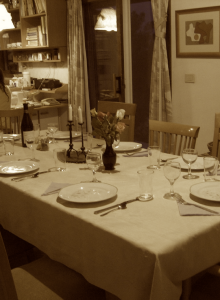Tag : High Holidays
January 10, 2019 by admin
Synagogue Anxiety
I have noticed that the word “itchy” comes up a lot when I talk about my synagogue anxiety. I think it goes back to the excitement of buying a new “temple” outfit every year. I’m a 1980s kid, and in my mind I’m still sitting in a pew, dressed up in a brandnew Benetton sweater dress, purchased for a crisp fall morning that was still many, many weeks away.
There I am, packed into a pew with my similarly bored family, shvitzing like crazy, gawking at the garish makeup on the women around me, and counting the minutes until we would all be out of our misery.
I’m an adult now, so no one can make me wear a sweater before the first morning frost. There’s no reason I can’t go as far away as possible for the yomtoyvim. In 2016, for instance, I spent Kol Nidre in a London pub with one set of lefty Jewish friends and “broke the fast” at a North London Chinese buffet with a couple of the Jewdas folks (no, Jeremy Corbyn wasn’t there). In between these celebrations, I communed with the mummies at the British Museum and reveled in my extreme lack of angst. But did I really have to travel of thousands of miles away from friends and loved ones to escape my problem with Jewish worship?
In 2018 my feelings around Yom Kippur got notably angrier. I may have raised a few eyebrows when I tweeted before Kol Nidre that I would not be humbling myself before a god who would allow a childabusing monster into the most powerful office in the world. Hashem? F that dude, I tweeted, with my usual subtlety. I didn’t bother to move my therapy appointment so it wouldn’t overlap with pretending to care about synagogue. As I walked down the street in clothes far from itchy, I felt defiant: let the entire Upper West Side know I wouldn’t be groveling before any judge, Heavenly, District Court or Supreme.
And yet, I still missed something. Starting in the late 1880s, radical Jews started organizing Yom Kippur balls, epic parties meant to demonstrate the participants’ emancipation from what they saw as old fashioned and stultifying tradition. As Eddy Portnoy notes, what was essential to those balls was first, that they were communal affairs and second, those participating had something to rebel against.
So where does that leave the solo abstainer a hundred years later?
ROKHL KAFFRISSEN, “Caught Between Skepticism and Yearning on the Holidays,” The Lilith Blog, October 10, 2018.
- No Comments
October 10, 2018 by Rokhl Kafrissen
Caught Between Skepticism and Yearning on the Holidays
Like a lot of American Jews, I have a complicated relationship to Jewish worship. Unlike most American Jews, it got complicated enough at one point that I wrote to a dog for advice.
Now, Tango isn’t just any dog. He’s a very wise pitbull who lives with a very wise friend of mine, Margie, in St. Paul, Minnesota. And the occasion wasn’t just any holiday, but Yom Kippur 2014, when all I wanted to do was hide in my apartment for 25 hours. My friend Margie announced that her dog was starting a new career as an advice columnist (yes, this really happened). Did I want to ask him a question? I once went all the way from New York City to Hoboken to talk to a psychic. Of course I wanted to ask Margie’s dog for advice.
- No Comments
September 6, 2018 by Erika Davis
My High Holiday Prayer: Stop Exploiting Jews of Color
About three months ago I invited over 20 Jews into my home for a havurah we call the Tacoma Shabbat Experiment. After my co-organizers and I finished leading Kabbalat Shabbat and the important bits of Ma’ariv, we sat down to a dinner that I’d prepared. I only planned for 20 people, and we had almost 30, but we found more plates, pulled up another table and folks sat on a hodgepodge of various lawn chairs and stools. Wine flowed, we tended to a pre-lit bonfire and folks meandered around the backyard my wife and I share with neighbors.
 I was saying goodbye to one woman when a man I didn’t know approached me and asked what my connection to Judaism was. Slightly tipsy and really pissed off, I quickly reminded him that his question was hugely problematic. He leaned in to ask about Ethiopian Jews and Ugandan Jews, hoping for some validation. Instead of realizing his misstep he continued to ask my connection to Judaism, claiming to not understand my objection to his line of questioning. Thankfully, a white Jewish woman stepped in and I turned my back to him to continue to say goodbye to a friend.
I was saying goodbye to one woman when a man I didn’t know approached me and asked what my connection to Judaism was. Slightly tipsy and really pissed off, I quickly reminded him that his question was hugely problematic. He leaned in to ask about Ethiopian Jews and Ugandan Jews, hoping for some validation. Instead of realizing his misstep he continued to ask my connection to Judaism, claiming to not understand my objection to his line of questioning. Thankfully, a white Jewish woman stepped in and I turned my back to him to continue to say goodbye to a friend.
This was not the first time a white Jew has questioned the authenticity of my Judaism based on the color of my skin. It was, however, the first time a white Jew had done this to me in my own home.
- 1 Comment
 Please wait...
Please wait...